Art and Bulls!
Feb. 23: The next morning dawns sunny and hot. We havebreakfast downstairs, where the ceiling is open up past the second floor.Someone is playing a flute outside and a cool breeze flows in. We tour thesquare around our hotel with José. The jardin has a beautiful fountain in themiddle, surrounded by trees of all kinds and bushes and flowers. People strollthrough it at all hours. The Ave Maria is a cathedral. Its wooden doors are enormousand ornate; it displays gold engravings everywhere, crystal chandeliers, andbeautifully tiled floors. Interestingly, all six of us agree that this ostentatiousgrandeur is sickening when we consider the fact that very poor peoplecontribute to it, even as they are starving and living in mud huts.
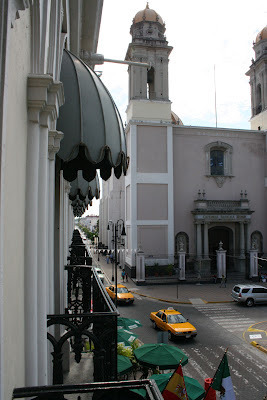
The church and its environs took twenty years to build,beginning in 1885. Underneath, we would find adobe brick, which has lasted allthis time. The plaster and painted façade, however, has been shaken andrefurbished a few times from earthquakes.
The convent next door is now agovernment building, the seat of the state governor. There's a huge opencourtyard in the centre, filled with palms and flowering bushes.
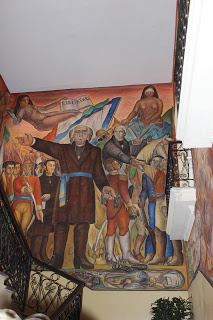
A painter,whose name is Correra I think), painted a beautiful mural up the wide marble staircasedepicting the history of the Mexican people. Justice and Liberty arerepresented by nubile women. He paints the Spanish conquerors as fierce lionswho come in and crush the eagle, since the eagle and the snake are Mexico'ssymbols. (The snake represents the lake upon which Mexico City was built.) TheAztecs fighting the Spanish is well drawn, depicting the terrors of war. An eleven-year revolution won Mexico's independence in 1810,but it wasn't until 1910 that the cruel hacienda system was overthrown. Thereis a big drawing of Emiliano Zapata in the mural. I instantly recognize him,since Marlon Brando played him in the movie. Vince remembers the story ofPancho Villa, who was Mexico's Robin Hood. A new constitution and the separation of church and state in1929 completed Mexico's transformation. José is rightfully proud of hiscountry. The next President might just be a woman, yay!
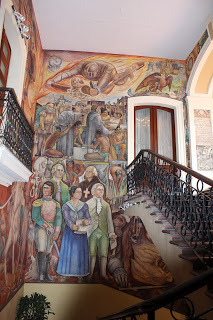
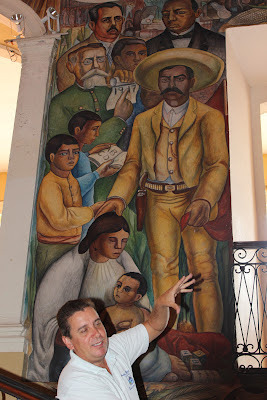 Emiliano Zapata aka Marlon Brando with José
Emiliano Zapata aka Marlon Brando with JoséFrom here, we drive to the Museum of Popular Art. It'sabsolutely fascinating. At the door, we're met by huge models of MagisterioTeresa Pomero and her husband. She was a founder of the museum and a reveredart teacher. Traditional masks and dress, huge multi-colored diadems, some witheagle feathers, some depicting good and some evil. Many revel in the concept ofdeath. José tells us that Mexicans celebrate death, since it is inevitable andsomething everyone will experience, they believe in removing the dreadsurrounding it. Their Aztec ancestors believed in reincarnation and preparedbodies for their travels in the next world with food and necessary articles. OnNovember 2 every year, they have a huge festival in celebration of death. Somepeople walk from Manzanillo to Mexico City, and do part of the pilgrimage ontheir knees. Mexicans still wear masks during festivals. There are tapestries with vivid colours and embroidery. Adragon is so exquisite that we gasp, but can't make out the material that it'sconstructed from; perhaps a thin ceramic. One headdress looks like an upsidedown lampshade. One model shows its entire body painted with symbols. Anotheris a man on a stick horse. One has a mermaid's tail. Tigers, jaguars, all kindsof masks with various looks and colors and decorations. The embroidery on theclothing is exquisite. We see traditional stringed instruments, drums,furniture (some of the Hidalgo style), toys, pottery, carvings, dolls, andminiatures. One miniature depicts the voladores de papantla, which we saw inPuerto Vallarta: people climb a pole and then unravel downwards in concentriccircles. Beautifully carved horses make me think of Leedalo. As we are nearing the exit, Vince spies some artists workingin an open courtyard, so we go out to see. Two people are working on papiermaché effigies. Two others, an older man and a younger, along with a woman whoseems to be in charge of the area, are doing pottery. To our surprise anddelight, the older man turns out to be the sculptor of the huge dancing dogsthat greet us on our entry into Colima! We get his picture and are able toshake his hand. Vince then hears some music coming from a basement, just afew steps down from the courtyard. We ask if we can go in, and the woman getspermission. There are four young men practicing their various instruments,three with different types of guitars (don't ask me what they are called) andone with a flute. They play us a beautiful traditional song. It's again one ofthose moments: just by chance, we are privileged to hear these talented people. Afterward, we check out of the hotel but are able to watchthe parade from our balconies and drink some lovely cold beer and margaritas.Some of the horses that will participate in the rodeo dance up the street.They'll head to Alvarez, gathering other riders as they go. Leading the entiregroup is Mo. Teresa and her hubby! Teachers are revered in Colima. We beat them in the van to Alvarez and park beside thebullring. It's constructed by about a couple of hundred people every year, allfamilies who "own" a section of the ring, everything done by hand, weaved,nailed, and posted. See the pictures to get the idea!
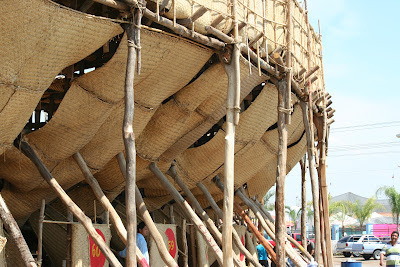
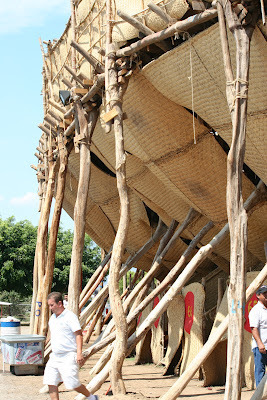
We "rent" our seats inSection 65. Soon the Pomeros arrive and behind them come the horses of therodeo: brown, silver, black, white, combinations of colors, every one of themgorgeous, sleek and strong. A man on a donkey comes up and mocks us gringoes (we're notsure what he's saying). Someone behind us growls at him. José says they areembarrassed by the rider's behavior, and stated that "you don't have to studyto be a clown". Everyone else seems pleased to see the gringos in their midst.The riders are young, old, and in between. The horses danceto the beat of the music, bow, circle, and move precisely as their owners dorope tricks. One man stands on his horse and loops the rope from his head tothe ground, in almost invisible circles.
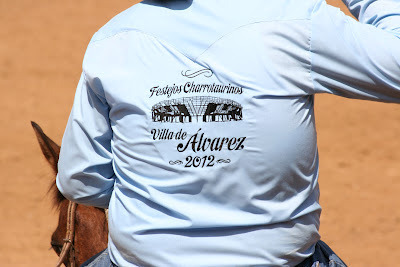
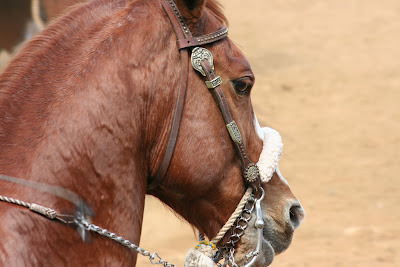
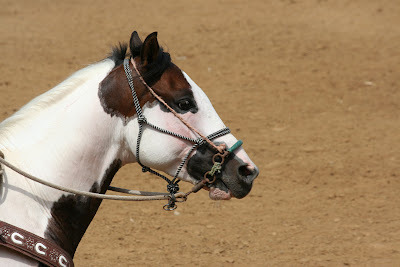
We drink cold cervesa, try watermelon with crushed peppers,and guavavilla. Maire, Rosaleen and I take a shot of tequila from the horn of abull. When the first bull comes into the circle, we are ready!The first bull is a hefty brown guy who shakes off his riderfairly quickly and immediately gets roped. He goes down in a cloud of dust, hishead and legs trussed. They untie him and he heads knowingly for the exit. Thesecond bull is feisty and we cheer for him. He shakes off his rider right awaythen does several mad runs around the ring before he is finally roped. Thethird bull heads to the exit at the beginning. This one is smart! He stops,trying to get the rider to slide off the front. He is coaxed back up, but therider gets off and the bull goes out the exit on his own. The fourth bull, awhite one, has some trouble getting his rider off, but finally does. Then heraces all around, kicking up dust, avoiding the ropes. Eventually, he goes downright in front of us, the dust in the air flowing over our heads.
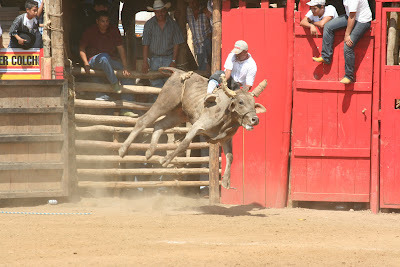
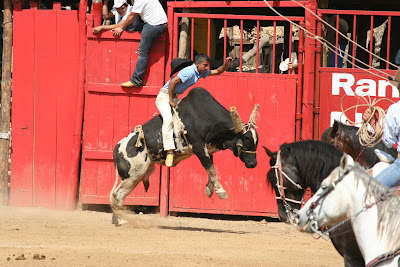 The first part of the rodeo is over. They will be off to a big lunch now and the bull fight will happen later - which we are not staying for. The horses dance for usas they exit. One rider comes up to talk. He lives in Fresno, California, andspeaks English well. We give him a beer and he shares a bit about his life. He"loves his damned old rodeo" and comes every year.
The first part of the rodeo is over. They will be off to a big lunch now and the bull fight will happen later - which we are not staying for. The horses dance for usas they exit. One rider comes up to talk. He lives in Fresno, California, andspeaks English well. We give him a beer and he shares a bit about his life. He"loves his damned old rodeo" and comes every year.
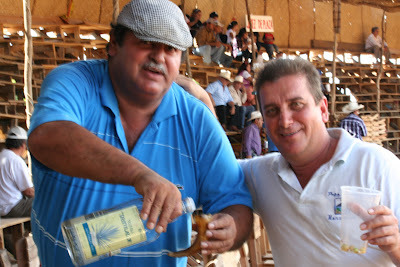 Jose´and our Tequila Man
Jose´and our Tequila Man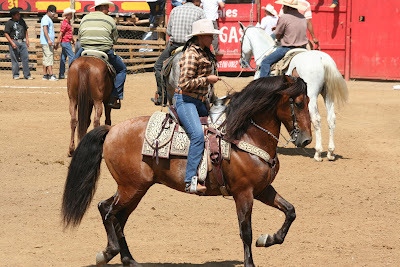
On the way out, we meet a family with a handicapped son. Hemust be studying English, because his mother points us out as "English" and hesmiles and shakes my hand. It's an encounter that's so indicative of thefriendliness of the Mexican people. I know that's a generalization, but sometimes you get afeeling from an area, or an atmosphere, and that's what we feel here.We leave Alvarez and have lunch in a beautiful open-airrestaurant near Colima. A mariachi band entertains us with lovely traditionalmusic while we feast on delicious meat and vegetables and beer and margaritas.When we're finished our meal, we sit and watch the dancers in gorgeouscostumes. Then out comes a fabulous singer, whose name is Flor Margarita (stagename?). She keeps us enthralled for a long time and afterward we buy her cd's.
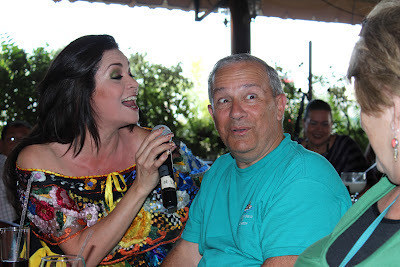
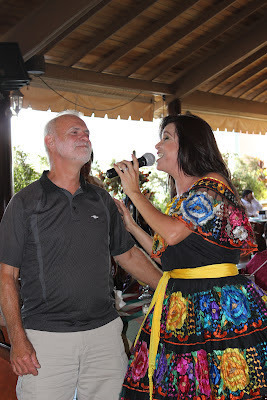
We're on the way home feeling thrilled and exhausted, but wewould do that trip all over again.
Published on February 25, 2012 09:21
No comments have been added yet.



